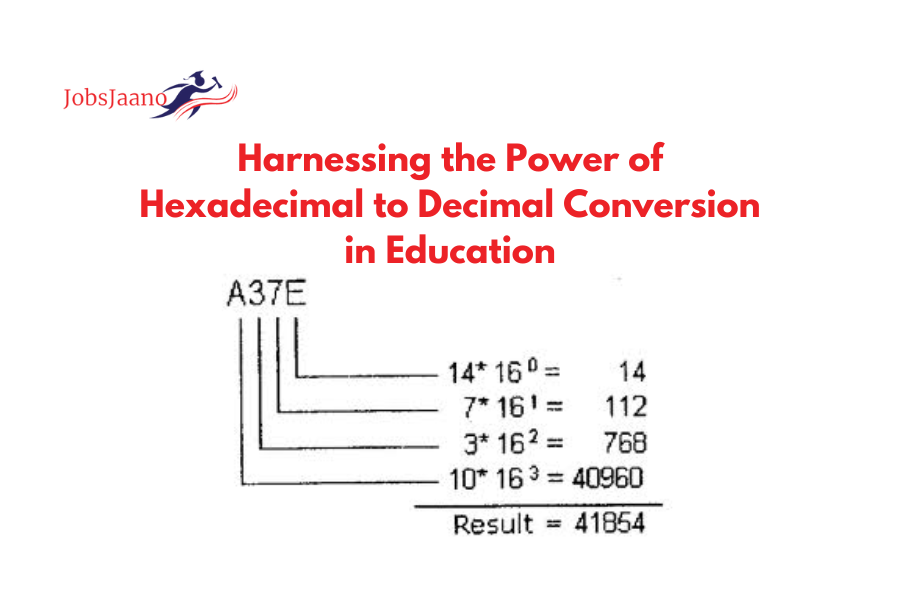Harnessing the Power of Hexadecimal to Decimal Conversion in Education:
Introduction
The world of education is constantly evolving, with educators and students seeking innovative ways to enhance learning experiences. One such innovation that has gained traction in recent years is the use of hexadecimal to decimal conversion as a teaching tool. Hexadecimal, often abbreviated as hex, is a base-16 numeral system, while decimal is the base-10 system that we use in our daily lives. By introducing hexadecimal to decimal conversion in education, we open doors to a deeper understanding of mathematics, computer science, and problem-solving skills. In this article, we will explore how the use of hex to decimal conversion can benefit education across various levels.
Hexadecimal Basics
Hexadecimal is a numbering system that uses 16 symbols to represent values. It uses the digits 0-9 to represent values 0-9, and the letters A-F to represent values 10-15. For example, in hexadecimal, the number 10 is represented as ‘A,’ 15 as ‘F,’ and 16 as ’10.’ Hexadecimal is commonly used in computer science and programming due to its direct relationship with binary (base-2) notation, where each hexadecimal digit corresponds to a 4-bit binary sequence.
Utilising Hex to Decimal in Education
Understanding Number Systems: Introducing students to hexadecimal alongside the familiar decimal system can deepen their understanding of number systems. This helps in expanding their mathematical horizons and paves the way for future learning in computer science, engineering, and digital technology.
Computer Science Education: Hexadecimal plays a crucial role in computer science. Teaching students hex to decimal conversion is a fundamental step in understanding how computers represent and process information. It also helps students to comprehend hexadecimal color codes, memory addresses, and bitwise operations.
Problem Solving: Converting between hexadecimal and decimal requires critical thinking and problem-solving skills. Students must grasp the concept of place value and practice mental math to perform conversions accurately. This promotes logical reasoning and mental agility.
Real-World Applications: Hexadecimal is not limited to the world of computers. It has practical applications in various fields, such as cryptography, robotics, and electrical engineering. Teaching students hex to decimal conversion can empower them to explore these domains.
Programming and Coding: Programming languages like Python and C often use hexadecimal notation for various purposes. An understanding of hex is essential for aspiring programmers, as it enables them to work with memory addresses, data manipulation, and debugging more effectively.
Encouraging Curiosity: Learning hex to decimal conversion can spark curiosity and engagement among students. It presents an opportunity for teachers to introduce unique and exciting mathematical concepts, making the learning process more enjoyable.
Integration into the Curriculum
To effectively integrate hex to decimal conversion into the educational curriculum, educators can consider the following strategies:
Visual Aids: Use visual aids like charts and diagrams to illustrate the relationship between hex and decimal values.
Interactive Tools: Incorporate online tools and calculators that allow students to practice conversions in a fun and engaging way.
Real-World Examples: Show real-world examples of hexadecimal usage, such as RGB color codes in digital art or hexadecimal addresses in memory management.
Practical Exercises: Assign practical exercises and projects that require students to convert between hex and decimal, reinforcing their skills through hands-on learning.
Conclusion
The inclusion of hex to decimal conversion in education enriches students’ mathematical knowledge and equips them with valuable skills for future endeavors in fields like computer science, engineering, and technology. Beyond its technical applications, hex to decimal conversion fosters problem-solving abilities and promotes a deeper understanding of number systems. By harnessing the power of hexadecimal in education, we empower students to embrace the increasingly digitized world with confidence and competence.

